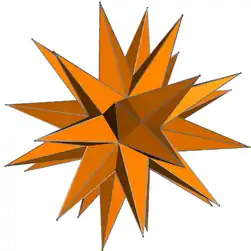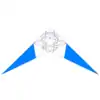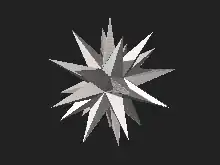| Great deltoidal hexecontahedron | |
|---|---|
 | |
| Type | Star polyhedron |
| Face |  |
| Elements | F = 60, E = 120 V = 62 (χ = 2) |
| Symmetry group | Ih, [5,3], *532 |
| Index references | DU67 |
| dual polyhedron | Nonconvex great rhombicosidodecahedron |

3D model of a great deltoidal hexecontahedron
In geometry, the great deltoidal hexecontahedron (or great sagittal ditriacontahedron) is a nonconvex isohedral polyhedron. It is the dual of the nonconvex great rhombicosidodecahedron. It is visually identical to the great rhombidodecacron. It has 60 intersecting cross quadrilateral faces, 120 edges, and 62 vertices. Its faces are darts. Part of each dart lies inside the solid, hence is invisible in solid models.
It is also called a great strombic hexecontahedron.
Proportions
The darts have two angles of , one of and one of . The dihedral angle equals . The ratio between the lengths of the long and short edges is .
References
- Wenninger, Magnus (1983), Dual Models, Cambridge University Press, ISBN 978-0-521-54325-5, MR 0730208
External links
This article is issued from Wikipedia. The text is licensed under Creative Commons - Attribution - Sharealike. Additional terms may apply for the media files.